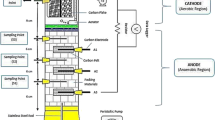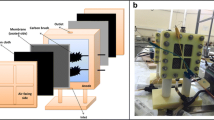Abstract
The voltage and the power production of two gram negative and two gram positive bacteria in four identical continuous flow microbial fuel cells combined with biological wastewater treatment units were evaluated and compared in the present study. Each microbial fuel cell and biological treatment unit was operated at four different flow rates and four different external load resistances. The results show that overall removal efficiency of chemical oxygen demand for all four systems can reach more than 85.5 %. Each pure culture has different power generation performance that can be affected by some factors, such as wastewater characteristics, influent flow rate and hydraulic retention time of reactor. Good linear relationships between the flow rate and the potential and between the flow rate and the power density on four pure cultures at different external load resistances were found. Comamonas testosteroni has better power generation performance than Arthrobacter polychromogenes, especially at higher flow rate. Although Pseudomonas putida also showed higher power generation than Corynebacterium glutamicum, the difference was not statistically significant. It seems that gram negative bacteria could display higher power generation than gram positive bacteria at higher flow rate. However, more evidence is required to provide stronger proof for the difference of power generation between gram negative and gram positive bacteria.
Similar content being viewed by others
References
Behera, M.; Ghangrekar, M. M., (2009). Performance of microbial fuel cell in response to change in sludge loading rate at different anodic feed pH. Bioresour. Tech., 100(21), 5114–5121 (8 pages).
Biffinger, J. C.; Byrd, J. N.; Dudley, B. L.; Ringeisen, B. R., (2008). Oxygen exposure promotes fuel diversity for Shewanella oneidensis microbial fuel cells. Biosens. Bioelectron., 23(6), 820–826 (7 pages).
Bond, D. R.; Lovley, D. R., (2003). Electricity production by Geobacter sulfurreducens attached to electrodes. Appl. Environ. Microbiol., 69(3), 1548–1555 (8 pages).
Chaudhuri, S. K.; Lovley, D. R., (2003). Electricity generation by direct oxidation of glucose in mediatorless microbial fuel cells. Nat. Biotech., 21, 1229–1232 (4 pages).
Chen, Y. H.; Chen, C. Y.; Lee, S. C., (2010). Technology forecasting of new clean energy: The example of hydrogen energy and fuel cell. Afr. J. Bus. Manag., 4(7), 1372–1380 (9 pages).
Clesceri, L. S.; Greenberg, A. E.; Eaton, A. D., (). Standard methods for the examination of water and wastewater, American Public Health Association (APHA), American Water Works Association (AWWA) and Water Environment Federation (WEF).
Debabov, V. G., (2008). Electricity from Microorganisms. Microbiol., 77(2), 123–131 (9 pages).
Du, Z.; Li, H.; Gu, T., (2007). A state of the art review on microbial fuel cells: A promising technology for wastewater treatment and bioenergy. Biotech. Adv., 25(5), 464–482 (19 pages).
El Diwani, G.; El Rafie, S.; Hawash, S., (2009). Degradation of 2, 4, 6-trinitotoluene in aqueous solution by ozonation and multi-stage ozonation biological treatment. Int. J. Environ. Sci. Tech., 6(4), 619–628 (10 pages).
Finch, A. S.; Mackie, T. D.; Sund, C. J.; Sumner, J. J., (2011). Metabolite analysis of Clostridium acetobutylicum: Fermentation in a microbial fuel cell. Bioresour. Tech., 102(1), 312–315 (4 pages).
Ghangrekar, M. M.; Shinde, V. B., (2007). Performance of membrane-less microbial fuel cell treating wastewater and effect of electrode distance and area on electricity production. Bioresour. Tech., 98(15), 2879–2885 (7 pages).
Juang, D. F.; Chiou, L. J., (2007). Microbial population structures in activated sludge before and after the application of synthetic polymer. Int. J. Environ. Sci. Tech., 4(1), 119–125 (7 pages).
Kim, B. H.; Kim, H. J.; Hyun, M. S.; Park, D. H., (1999). Direct electrode reaction of Fe (III) reducing bacterium, Shewanella putrefacience. J. Microbiol. Biotech., 9, 127–131 (5 pages).
Kim, H. J.; Park, H. S.; Hyun, M. S.; Chang, I. S.; Kim, M.; Kim, B. H., (2002). A mediator-less microbial fuel cell using a metal reducing bacterium, Shewanella putrefacians.Enzyme Microb. Tech., 30, 145–152 (8 pages).
Lee, S. C.; Shih, L. H., (2010). Renewable energy policy evaluation using real option model-The case of Taiwan. Energy Econ., 32(Supplement 1), 567–578 (12 pages).
Li, Z. L.; Yao, L.; Kong, L. C.; Liu, H., (2008). Electricity generation using a baffled microbial fuel cell convenient for stacking. Bioresour. Tech., 99(6), 1650–1655 (6 pages).
Liu, H.; Cheng, S.; Huang, L.; Logan, B. E., (2008). Scale-up of membrane-free single-chamber microbial fuel cells. J. Power Sources, 179(1), 274–279 (6 pages).
Logan, B. E.; Regan, J. M., (2006). Electricity-producing bacterial communities in microbial fuel cells. Trends Microbiol., 14(12), 512–518 (7 pages).
Mathuriya, A. S.; Sharma, V. N., (2009). Bioelectricity production from paper industry waste using a microbial fuel cell by Clostridium species. J. Biochem. Tech., 1(2), 49–52 (4 pages).
Min, B.; Cheng, S.; Logan, B. E., (2005). Electricity generation using membrane and salt bridge microbial fuel cells. Water Res., 39(9), 1675–1686 (12 pages).
Mohan, S. V.; Mohanakrishna, G.; Sarma, P. N., (2010). Composite vegetable waste as renewable resource for bioelectricity generation through non-catalyzed open-air cathode microbial fuel cell. Bioresour. Tech., 101(3), 970–976 (7 pages).
Park, H. S.; Kim, B. H.; Kim, H. S.; Kim, H. J.; Kim, G. T.; Kim, M.; Chang, I. S.; Park, Y. K.; Chang, H. I., (2001). A novel electrochemically active and Fe(III)-reducing bacterium phylogenetically related to Clostridium butyricum isolated from a microbial fuel cell. Anaerobe, 7(6), 297–306 (10 pages).
Rabaey, K.; Boon, N.; Siciliano, S. D.; Verhaege, M.; Verstraete, W., (2004). Biofuel cells select for microbial consortia that self-mediate electron transfer. Appl. Environ. Microbiol., 70(9), 5373–5382 (10 pages).
Rabaey, K.; Verstraete, W., (2005). Microbial fuel cells: novel biotechnology for energy generation. Trends Biotech., 23(6), 291–298 (8 pages).
Refaat, A. A., (2009). Correlation between the chemical structure of biodiesel and its physical properties. Int. J. Environ. Sci. Tech., 6(4), 677–694 (18 pages).
Refaat, A. A., (2010). Different techniques for the production of biodiesel from waste vegetable oil. Int. J. Environ. Sci. Tech., 7(1), 183–213 (31 pages).
Rodrigo, M. A.; Cañizares, P.; Lobato, R.; Paz, R.; Sáez, C.; Linares, J. J., (2007). Production of electricity from the treatment of urban waste water using a microbial fuel cell. J. Power Sources, 169(1), 198–204 (7 pages).
Schroder, U.; Nieben, J.; Scholz, F., (2003). A generation of microbial fuel cells with current outputs boosted by more than one order of magnitude. Angew. Chem. Int. Ed. Engl., 42(25), 2880–2883 (4 pages).
Sun, J.; Hu, Y.; Bi, Z.; Cao, Y., (2009). Improved performance of air-cathode single-chamber microbial fuel cell for wastewater treatment using microfiltration membranes and multiple sludge inoculation. J. Power Sources, 187(2), 471–479 (9 pages).
Watson, V. J.; Logan, B. E., (2010). Power production in MFCs inoculated with Shewanella oneidensis MR-1 or mixed cultures. Biotech. Bioeng., 105(3), 489–498 (10 pages).
You, S. J.; Zhao, Q. L.; Jiang, J. Q.; Zhang, J. N., (2006). Treatment of domestic wastewater with simultaneous electricity generation in microbial fuel cell under continuous operation. Chem. Biochem. Eng. Q., 20(4), 407–412 (6 pages).
Zhang, T.; Cui, C.; Chen, S.; Yang, H.; Shen, P., (2008). The direct electrocatalysis of Escherichia coli through electroactivated excretion in microbial fuel cell. Electrochem. Commun., 10(2), 293–297 (5 pages).
Author information
Authors and Affiliations
Corresponding author
Rights and permissions
About this article
Cite this article
Juang, D.F., Yang, P.C., Lee, C.H. et al. Electrogenic capabilities of gram negative and gram positive bacteria in microbial fuel cell combined with biological wastewater treatment. Int. J. Environ. Sci. Technol. 8, 781–792 (2011). https://doi.org/10.1007/BF03326261
Received:
Revised:
Accepted:
Published:
Issue Date:
DOI: https://doi.org/10.1007/BF03326261




